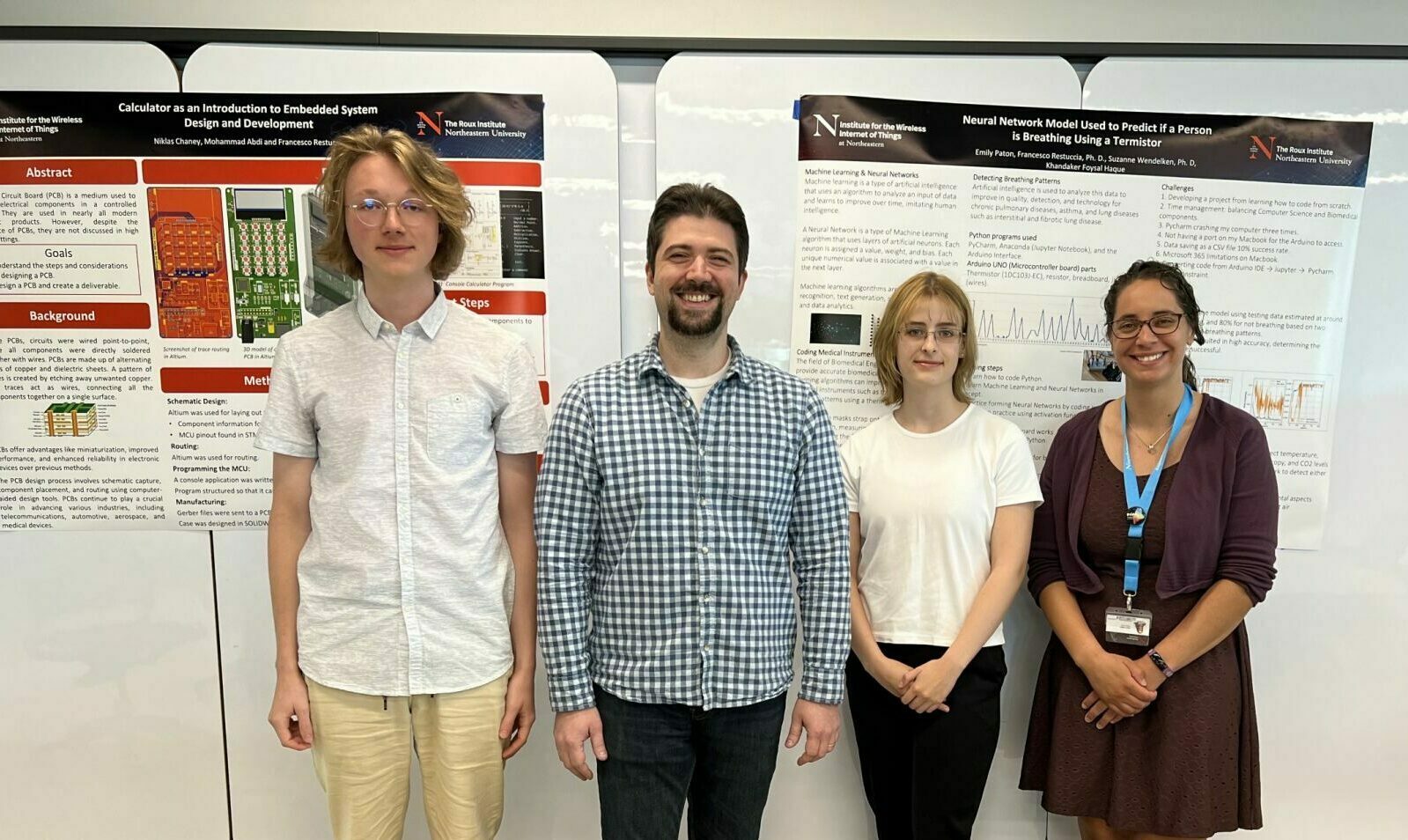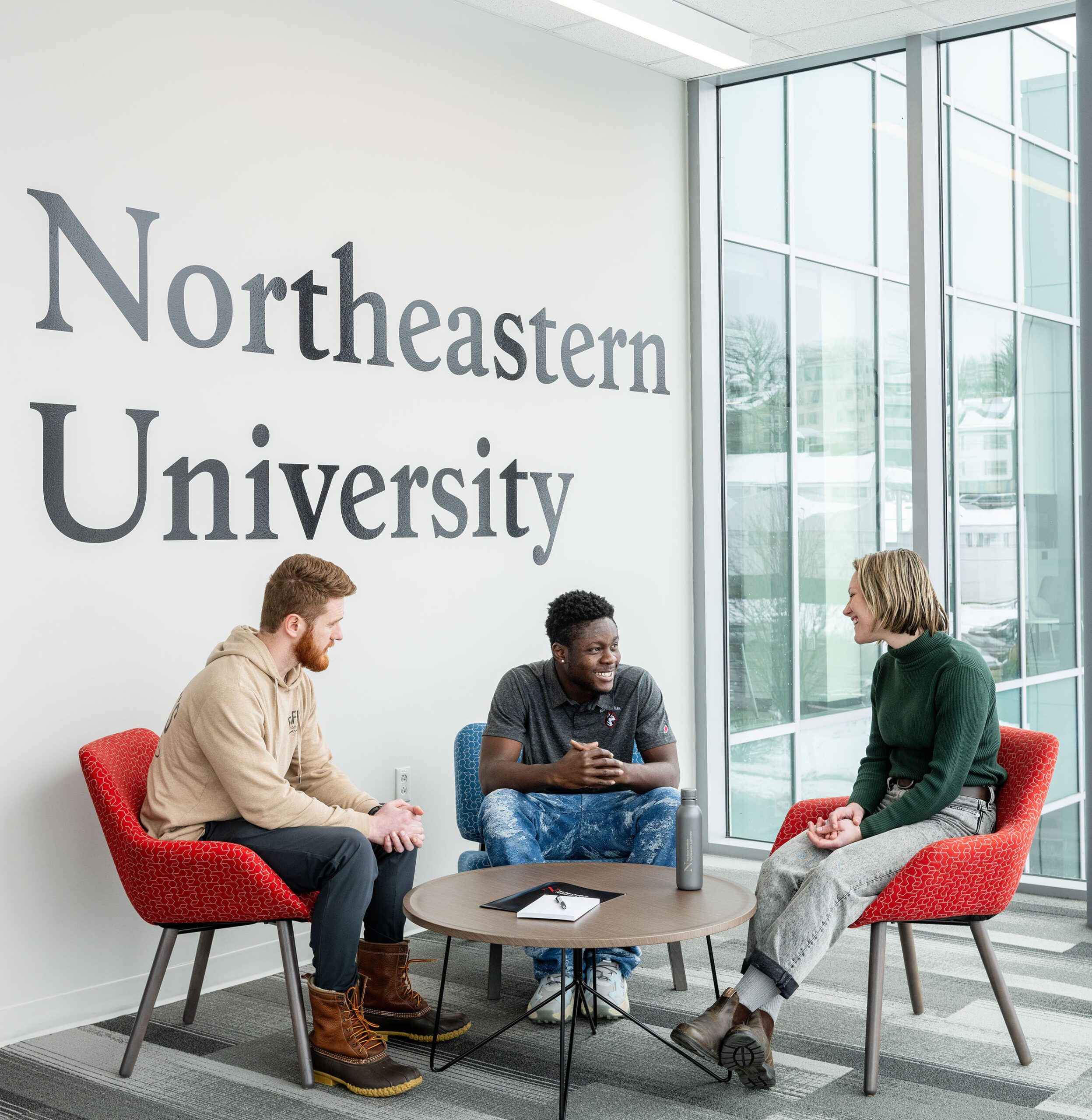
Young scholars spend the summer making big discoveries at the Roux Institute
What did high schoolers Emily Paton and Niklas Chaney do over their summer vacation? Maybe not what you’d expect of two teenagers, unless you somehow guessed “worked with world-class researchers on cutting-edge technologies.” But that’s exactly the case for Paton and Chaney, the two students who made up the inaugural cohort of the Roux Institute’s Young Scholars’ Program.
At a presentation that was the culmination of the six-week program, Paton, a rising senior at Portland High School, walked the audience through her experience working with Roux faculty, researchers, and graduate students on an oxygen mask that could detect whether a person is breathing. The project introduced her to neural networks, a type of machine learning that uses interconnected nodes or neurons to process information in a way that resembles the human brain.
Chaney, a rising senior at Waynflete’s Upper School in Portland, settled on something similarly ambitious: building a calculator from scratch to better understand embedded system design and development. This involved creating his own printed circuit board, or PCB, and writing the software to run the calculator.

The opportunity to complete these projects comes from a Northeastern-led program that places rising high school seniors in science and engineering labs to explore STEM opportunities not typically available through high schools. Northeastern University’s Executive Director for The Center for STEM, Claire Duggan, designed the program in 1989 with funding from the National Science Foundation and still oversees it today. Northeastern has seen over 600 participants of the program, with 75% of those reporting to have pursued or completed an undergraduate program in STEM. The Roux Institute is the first Northeastern campus outside of Boston to implement the program.
Paton and Chaney were placed in a Roux engineering lab under the tutelage of Francesco Restuccia, an assistant professor of computer and electrical engineering at Northeastern and a prominent researcher in wireless communications, artificial intelligence, embedded systems, and wireless security. His lab is part of Northeastern’s Institute the Wireless Internet of Things, a research institute dedicated to studying wireless communications. It was Restuccia’s idea to bring the Young Scholars’ Program to the Roux Institute, and he acted as the lead advisor to the students, while other Roux faculty, researchers, and graduate students worked closely Chaney and Paton on their projects.
“Before taking this program, I considered electrical engineering as something that was way beyond me. This program made it much more approachable by putting me in a position where I had the support that I needed to figure a new thing out.”
NIKLAS CHANEY
Young Scholar Program Participant
Chaney said that the opportunity to work with the faculty and graduate students at the Roux Institute opened his mind to what he’s capable of. “Before taking this program, I considered electrical engineering as something that was way beyond me. This program made it much more approachable by putting me in a position where I had the support that I needed to figure a new thing out,” Chaney said.
Both students learned what it was like to run up against a host of challenges while trying to complete complex projects in just six weeks. “I had to teach myself Python in a week,” Paton said, referring to a programming language she had to learn from scratch before she could even start her project. Even so, the successes outweighed the challenges, and the real value of the program wasn’t in the final outcomes, but the interactions and connections made along the way.
“The one-on-one conversations with Francesco and other helpers, talking about the field and explaining concepts, that was a really positive experience,” remarked Chaney.
Paton was equally inspired watching Roux graduate students as they worked on projects alongside her. “I loved talking to the graduate students and seeing how focused they were on their projects. I aspire to have that passion and knowledge for a project someday. “
Paton said the program offered her the space and independence to really explore what type of engineering she’d like to focus on when she eventually pursues a degree in the field. And while she enjoyed dabbling in biomedical engineering during her time in the program, she said she’s more inspired than ever to explore other aspects of engineering, particularly aerospace. “I just want to be engaged in engineering and innovative, modern science as early as possible. I want to be around it,” she said.
“I loved talking to the graduate students and seeing how focused they were on their projects. I aspire to have that passion and knowledge for a project someday.”
EMILY PATON
Young Scholars Program Participant
The Roux Institute faculty and staff who attended the students’ final presentations were visibly impressed by the progress made in just a few short weeks. One professor in the audience remarked that both students had used techniques in their work that are taught in master’s level classes at the Roux Institute. The professor’s comment highlighted the central aim of the program, which is to give students access to next-level skills and opportunities not available to them in their high school classrooms.
Alicia Jalbert, who manages the program at the Roux Institute, was ecstatic about the program results and what Paton and Chaney accomplished. “They were already incredible students coming into the program, and adding in our layer of subject matter experts and giving them that hands-on experience, it just completely exceeded my expectations of what they were able to accomplish,” Jalbert said.

